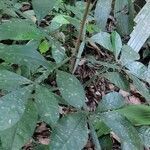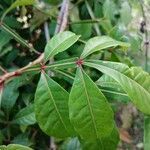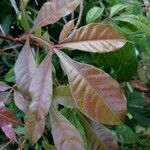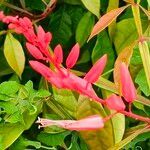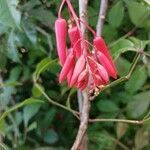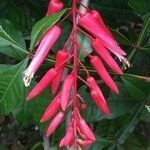Slender shrubs or small trees, 2-8 m high, the bark exfoliating in small flakes; branchlets reddish, angled. Leaves odd-pinnate, 21-31 cm long and 9-24 cm wide; petiole and rachis oblanceolate-winged, the wing to 15 mm wide apically, rarely also slightly auriculate; leaflets (3-)5(-7), opposite, obovate to oblanceolate, abruptly acuminate apically, cuneate basally, chartaceous, sessile, 4-22.5 cm long and 16-75 mm wide, the terminal usually largest. Racemes axillary or sometimes terminal or rarely cauliflorous, rarely paniculate basally, the branches red, minutely puberulent, 6.5-28 cm long. Flowers showy, the buds conical, the pedicels red, minutely puberulent, articulate below the apex, 5-30 mm long, subtended by a pubescent lanceolate bract ca. 2 mm long; sepals 5, pink to red, triangular, ciliate, ca. 1.5 mm long and wide; petals 5, pink to bright red, white within, lanceolate, pubescent basally within, 3-4 cm long and 5-6 mm wide, not spreading at anthesis; stamens 10, exserted, 3.5-4 cm long, the filaments filiform, appendaged basally, the appendages pubescent, coherent; intrastaminal disc conspicuous, 10-lobed, enlarging and becoming red in fruit; carpels 5, ovoid, free below, but con-nate above to form the style, the style as long as or longer than the stamens, to 5 cm long, deciduous, the stigma simple or slightly lobed. Drupes 1-S per flower, oblong, stalked, with a medial ridge, veined, glabrous, green to reddish, becoming dark red at maturity, ca. 15 mm long and 8 mm wide, forming a star-shaped cluster spreading from the broad red disc.
More
Very bitter, erect shrub, 2-3 m high. Leaves with broadly winged rachis; rachis + petiole c. 5-16 cm; leaflets usually 5, apical ones reduced to 3-1; flush purple; almost sessile, obovate-oblong. Racemes 10-25 cm long, often branched. Pedicels 8-14 mm, accrescent. Bracts spathulate, the lower most sometimes foliaceous, 3-14 mm long. Calyx patent, bright red, 7-8 mm. Petals bright red outside, whitish inside, 27-32 by 5-6 mm. Stamens longer than the petals, slightly unequal, 3.5-4 cm. Drupes 1-5, purple-black, 12-13 mm long.
A shrub or small tree. It grows 6 m high. The leaves are compound and alternate. They have leaflets along the stalk. There are 5 leaflets each 5-15 cm long. The flowering groups hang down. They have pink stems and are in groups 25 cm long. The flowers are 3-4 cm long and tube shaped. The petals are pink outside and white inside. The stamens stick out the end. There are up to five fruit in a group. They are black and have one seed. They are 1.5 cm long and on a red, enlarged stalk.
Has been cultivated in Tanzania (Lushoto District: Amani, plantation Sigi Juu 9, Dec. 1940, Greenway 6082!).. It has a winged rachis and large red flowers.
A native species of tropical America is cultivated in our area.
